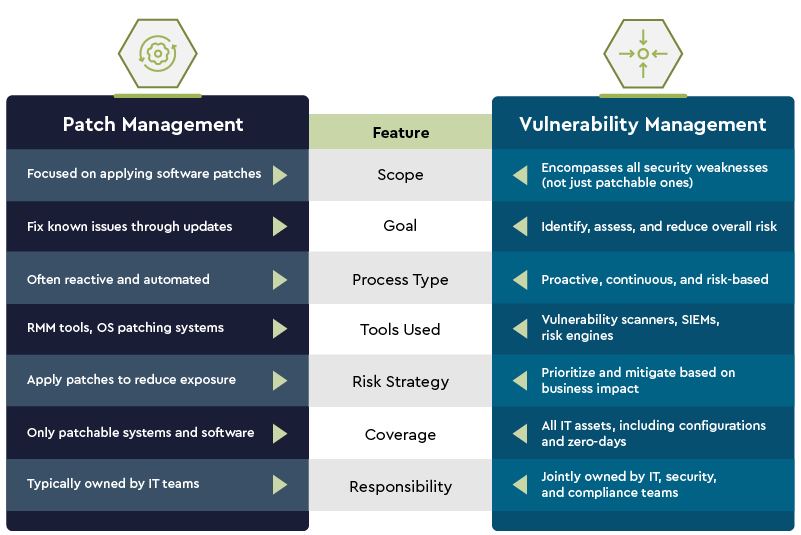Key takeaways
- Vulnerability management is a continuous, strategic process focused on identifying, assessing, prioritizing, and remediating security weaknesses across systems.
- Patch management is a tactical process within vulnerability management that applies software updates to fix known issues and prevent exploitation.
- While patching is part of vulnerability management, it’s not a complete solution on its own. Not all vulnerabilities can be fixed with a patch.
- Combining patch management and vulnerability management enables a proactive, risk-based approach to securing your IT infrastructure—far more powerful than using either in isolation.
- Delays or breakdowns in either process can leave organizations exposed to data breaches, compliance failures, and costly downtime.
- Effective security requires a coordinated, policy-driven approach that combines automated scanning, risk-based prioritization, and consistent patch deployment.
- To fully protect your environment, both processes must work in tandem, guided by your overall cybersecurity framework and risk tolerance.
Maintaining a strong cybersecurity posture requires more than just applying the occasional software update.
According to research from the World Economic Forum (WEF), 72% of organizations expect cyber risks to increase in 2025, with ransomware ranking as the most pressing concern.
The aftermath of a security incident can be far more expensive than investing in preventive measures. Cleanup costs. Regulatory fines. Reputational damage. Lost contracts. Increased insurance premiums. It all adds up. In fact, the average cost of a data breach reached nearly $4.9 million in 2024.
As attacks increasingly target known vulnerabilities, two critical strategies—patch management, and vulnerability management—have become essential for reducing risk and maintaining IT security. But while these terms are often used interchangeably, they serve different, though complementary, functions.
So what’s the difference between patch management vs vulnerability management? And how can organizations effectively use both to stay secure and compliant?
In this blog, we’ll break down:
- What patch management and vulnerability management really mean
- How they differ in scope, purpose, and execution
- Where they overlap—and how they work together to protect your systems
- Tools and best practices for integrating both into your IT operations
Whether you're part of an in-house IT team or a Managed Service Provider (MSP) looking to strengthen client defenses, understanding the distinction between these two processes is key to building a resilient, future-ready security strategy.
The difference between patch management and vulnerability management
While patch management and vulnerability management are closely related—and often work together—they serve distinct purposes within an organization’s cybersecurity strategy. Understanding their differences is critical for allocating resources, selecting the right tools, and building a layered defense.
Below is a breakdown of the primary differences:
Patch management vs vulnerability management: side-by-side comparison

What is patch management?
Patch management is the process of identifying, acquiring, testing, and deploying software updates—also known as patches—to fix known vulnerabilities, improve system performance, and introduce new features. These updates might come from third-party vendors (like Microsoft or Adobe) or from internal development teams, and may apply to operating systems, applications, firmware, or third-party software used across your IT environment.
The primary goal of patch management is to reduce security risks by closing gaps that could be exploited by attackers. However, effective patching also ensures system stability and compliance with industry regulations.
Patch management typically involves:
- Scanning systems to detect missing patches
- Prioritizing patches based on severity, risk, and business impact
- Testing patches to prevent compatibility issues
- Deploying patches at scheduled times to minimize disruption
- Documenting updates for audit and compliance purposes
Many IT teams and MSPs use patch management software to automate patch deployment across large, distributed environments. These tools help ensure patches are applied consistently and securely, without requiring manual effort for each device.
Ultimately, vulnerability patch management helps businesses stay ahead of evolving threats, protect sensitive data, and avoid the costly aftermath of a breach. Attackers move fast, and patching faster makes all the difference. With this said, it's important to understand that it's just one part of a larger vulnerability management strategy.
What is vulnerability management?
Vulnerability management is a broader, continuous cybersecurity process that involves identifying, assessing, prioritizing, and remediating security weaknesses across an organization’s entire IT environment. While patching known software flaws is one part of this strategy, vulnerability management covers all potential exposures—not just those that can be fixed with a patch.
It’s a continuous lifecycle that includes:
- Asset discovery to identify what devices, systems, and applications are in use
- Vulnerability scanning using tools that detect known risks, misconfigurations, outdated software, or missing patches
- Risk assessment based on the severity of the vulnerability and the value of the asset
- Remediation or mitigation planning, which may include patching, configuration changes, segmentation, or even software replacement
- Continuous monitoring and reporting to track progress and ensure timely response to new threats
Unlike patch management, which is often automated and task-specific, vulnerability management is strategic and risk-driven. It requires coordination between security teams, IT operations, and even compliance stakeholders to ensure the most critical vulnerabilities are addressed first.
For example, a vulnerability may be discovered for which no patch currently exists. In that case, a good vulnerability management strategy will still recommend interim actions—like disabling services, applying virtual patches, or increasing monitoring—to reduce exposure.
In short, vulnerability management provides a holistic view of your organization’s attack surface, while patch management focuses on fixing a subset of those risks with available updates.
How patch management and vulnerability management work together
While patch management and vulnerability management serve different functions, they are most effective when used together as part of a unified cybersecurity strategy. One is not a replacement for the other—in fact, they complement each other to reduce risk across your IT environment.
Effective vulnerability and patch management begins with visibility. You can’t fix what you don’t know exists, so the first step is identifying vulnerabilities across your environment.
Here’s how the relationship works:
Patch management as a subset of vulnerability management
Patch management is one of the key remediation actions within a larger vulnerability management program. After vulnerabilities are identified and prioritized through scanning and assessment, patching is often the first and most direct way to eliminate a known threat.
Here’s a closer breakdown of this process:
Step 1: Spot the cracks with vulnerability scanners
Everything starts with vulnerability scanners, which automatically search systems and devices for known weaknesses. They compare the organization’s environment against a constantly updated database of Common Vulnerabilities and Exposures (CVEs) and flag issues based on severity.
Scanners help build a clear inventory of what needs patching and where the biggest risks lie.
Step 2: Monitor endpoints
Endpoint agents take things a step further. Installed on individual devices, they monitor for missing patches, misconfigurations, and outdated software in real time. They provide granular visibility into the health of each endpoint and can be configured to trigger automated patch deployment, reducing manual work for IT teams.
Step 3: Watch for signs of trouble
Automated solutions can also draw information from a variety of logging systems. If a particular system is repeatedly targeted by abnormal traffic, it could indicate an unpatched vulnerability. This raises a red flag indicating that urgent attention is needed.
Step 4: Test to uncover vulnerabilities
Penetration tests simulate real-world attacks. Unlike automated scans, pen tests consider the creative tactics a real attacker might use, identifying vulnerabilities and blind spots that scanners may miss.
Step 5: Prioritize the threats
Once vulnerabilities are identified, the process continues with prioritization. The most critical risks must be addressed first and without delay. This stage is key to avoiding unnecessary downtime and ensuring business continuity.
Step 6: Test before deployment and verify
Next comes testing. Before deployment, validate patches in a staging environment to prevent compatibility issues or disruptions to core systems. After testing, deploy them using centralized patch management tools that track compliance and automate rollouts.
Finally, verification ensures that patches were installed correctly and that systems are secure.
When patching isn’t enough
Not all vulnerabilities can be resolved through patching:
- Some systems may be end-of-life and no longer supported
- A patch may not be available yet (zero-day vulnerability)
- Patching may require downtime that's not feasible in the short term
In these cases, vulnerability management teams take alternative actions such as:
- Virtual patching via firewalls or endpoint protection
- Disabling vulnerable services
- Increasing monitoring or access controls
Collaboration between teams and tools
For optimal results, patch and vulnerability management efforts should:
- Share asset inventory and risk data
- Coordinate through shared platforms (e.g., RMM, SIEM, or vulnerability management software)
- Define cross-functional roles between IT operations, security, and compliance teams
Together, these processes ensure that:
- Known threats are patched quickly
- Emerging vulnerabilities are addressed—even without immediate fixes
- Security gaps are minimized through layered defense
Vulnerability management and patching challenges
Both vulnerability management and patch management come with distinct challenges that can delay remediation and leave systems exposed to risk.
Here’s where efforts often stall:
- Overwhelming scan results: Vulnerability scanners can produce thousands of alerts, many of which are false positives or low-risk issues. Sifting through them to find the true priorities can take substantial time and expertise.
- Unclear ownership: In hybrid or siloed environments, it’s often unclear who is responsible for which part of the vulnerability lifecycle. Without defined accountability, both patch deployment and broader vulnerability remediation efforts can fall through the cracks.
- Scheduling conflicts: IT teams must often coordinate updates during off-hours to avoid service disruptions. But in 24/7 operational environments, finding a “safe” deployment or testing window can be nearly impossible, leading to delays that extend vulnerability exposure.
- Lack of automation: Manually scanning for vulnerabilities and/or patching consumes time and resources, which are in short supply for most IT teams. Without automation, human error becomes a real threat. Even the best patching plans can fall apart due to miscommunication or missed steps.
- Insufficient testing: Deploying patches without first validating them in a controlled environment can make systems unstable. This is especially true of stacks comprising a wide variety of devices and/or software dependencies, as compatibility issues might lead to system instability, which could lead to unwanted downtime.
These challenges are not insurmountable, but they require visibility, clear processes, and the right tools to overcome. Following best practices for patch management and vulnerability testing can remove or reduce the barriers discussed above.
Common misconceptions about patch management and vulnerability management
Many organizations struggle with effectively implementing both patch management and vulnerability management—not because of the complexity of the tools, but due to misunderstandings about what each process does (and doesn't do). Clarifying these misconceptions is crucial for developing a mature, risk-aware security program.
Here are some of the most common myths:
Misconception 1: "Patching is the same as vulnerability management."
Patching is only one method of remediation. Vulnerability management goes far beyond applying updates—it includes identifying new threats, prioritizing based on risk, and mitigating vulnerabilities that have no available patch. Confusing the two leads to incomplete risk coverage.
Misconception 2: "If we automate patching, we’re secure."
While automated patch management tools are essential for scale and consistency, they can’t identify or prioritize risks on their own. Patching without vulnerability scanning means you may miss critical exposures—especially in misconfigurations, legacy systems, or non-patchable assets.
Misconception 3: "Patching can be delayed without much impact."
Delaying the application of critical security patches can leave your organization exposed to known, actively exploited vulnerabilities. Threat actors often exploit these flaws within days of public disclosure. A well-defined patch management policy ensures timely action aligned with business risk.
Misconception 4: "Only the security team handles vulnerability management."
Effective vulnerability management is a cross-functional effort. While security teams may lead the process, IT operations, compliance, and even business unit leaders must collaborate to ensure:
- Accurate asset inventories
- Informed decisions about risk and remediation
Misconception 5: "We only need to focus on operating system patches."
Vulnerabilities also exist in:
Limiting patch management to OS updates leaves significant gaps in your attack surface.
By debunking these misconceptions, MSPs and IT teams can build a stronger, more integrated patch and vulnerability management strategy—one that truly protects critical systems and data.
Best practices for vulnerability and patch management
To effectively and consistently reduce risk, organizations need a clear, scalable process that covers both the discovery of vulnerabilities and the deployment of fixes. Patch management is a critical part of this, but it must be integrated within a broader vulnerability management strategy.
Here are best practices that apply across the full vulnerability lifecycle, from identification to remediation:
- Assign clear ownership: Accountability is essential. Define who is responsible for each stage of the process—from scanning and assessing vulnerabilities to testing and deploying patches. This reduces delays, eliminates confusion, and improves cross-team coordination.
- Know your environment: Build and maintain an up-to-date asset inventory. Security teams need visibility into all software, hardware, and endpoints to identify where vulnerabilities exist and understand what needs patching.
- Set a defined scope and prioritization framework: Not all vulnerabilities are created equal. Use threat intelligence and risk scoring to determine which weaknesses pose the greatest risk. Prioritize patching based on severity, exploitability, business impact, and regulatory requirements.
- Create a formal vulnerability and patch management policy: Document processes for how vulnerabilities are identified, evaluated, and addressed. Include criteria for when to patch, how to test updates, and who signs off. A formal policy reduces guesswork and ensures consistency across environments.
- Promote cross-functional collaboration: Vulnerability management isn’t just a security task—IT operations, compliance, and development all play a role. Align teams around a shared workflow and ensure clear communication between stakeholders.
- Test in a sandbox before deploying: Whether addressing a single vulnerability or rolling out patches at scale, validate changes in a controlled environment. This helps uncover potential disruptions, compatibility issues, or performance impacts before they affect production systems.
- Automate wherever possible: Manual processes are slow, error-prone, and difficult to scale. Use automation for scanning, risk assessment, patch deployment, and compliance reporting to streamline workflows and reduce the time between detection and remediation.
By combining these best practices, organizations can strengthen both their proactive defense posture and their response capabilities, significantly reducing the risk of breaches due to unpatched vulnerabilities or mismanaged risk. For more information on setting up an effective patch management system, download our eBook, Patch Management Best Practices.
Choosing the right tools for patch and vulnerability management
To effectively implement both patch management and vulnerability management, you need the right tools—ideally ones that can work together or integrate seamlessly within your existing IT environment. The right solutions will not only automate routine tasks but also provide visibility, prioritization, and control over your entire attack surface.
Here’s what to consider when selecting tools:
Patch management software
Look for tools that allow you to:
- Automate OS and third-party application updates
- Schedule patch deployments during maintenance windows
- Group endpoints by patch policy, device type, or risk level
- Test and approve patches before full deployment
- Generate reports for compliance audits and performance tracking
Patch management software like ConnectWise RMM, offers robust patch scheduling, policy enforcement, real-time alerts, and integrated support for Windows and third-party software updates.
Vulnerability management software
Choose solutions that:
- Continuously scan for vulnerabilities across all IT assets (workstations, servers, cloud, etc.)
- Offer risk-based prioritization using threat intelligence and business context
- Integrate with remediation workflows and patch tools
- Support compliance frameworks like NIST, CIS Controls, PCI DSS
- Provide detailed dashboards and trend reporting
ConnectWise Risk Assessment offers a pre-sales endpoint vulnerability assessment tool that identifies security gaps, highlights dark web exposure, and equips MSPs with actionable insights to strengthen client security posture.
Look for integration and automation
To reduce overhead and improve response time:
- Choose tools that share asset inventories and risk data
- Automate workflows between vulnerability detection and patch deployment
- Ensure alerts and logs flow into your SIEM or SOC offering for centralized visibility
If you’re managing environments at scale—as an internal IT team or MSP—seamless integration between patch management, vulnerability assessment, and threat response ensures faster, more reliable outcomes with less manual intervention.
ConnectWise cybersecurity and data protection solutions are an enterprise ready tech stack trusted by MSPs of all sizes. From proactive vulnerability assessments and dark web monitoring with ConnectWise Risk Assessment, to automated patching and real-time compliance tracking with ConnectWise RMM, and advanced threat detection through ConnectWise SIEM and SOC services, ConnectWise delivers the tools MSPs need to protect, detect, and respond—at scale.
Conclusion: Why you need both patch and vulnerability management
As cybersecurity threats become more sophisticated and frequent, organizations can no longer afford to treat patch management and vulnerability management as interchangeable—or optional. Each plays a unique and essential role in minimizing risk.
When used together, these two processes help ensure a proactive, risk-based approach to IT security that protects your infrastructure, maintains compliance, and strengthens business continuity.
ConnectWise RMM leverages automation and intelligent monitoring and alerts to deliver real-time visibility into your IT environment, making patch management more efficient and reliable while saving your techs time from manual patching. Automating patch management via RMM helps IT proactively manage potential threats and vulnerabilities across multiple endpoints at scale, helping to mitigate risks and deliver a more secure IT environment for your clients.
Put our software to the test with a free 30-day trial of ConnectWise RMM and experience firsthand how automated patch management can help elevate your IT operations.

















